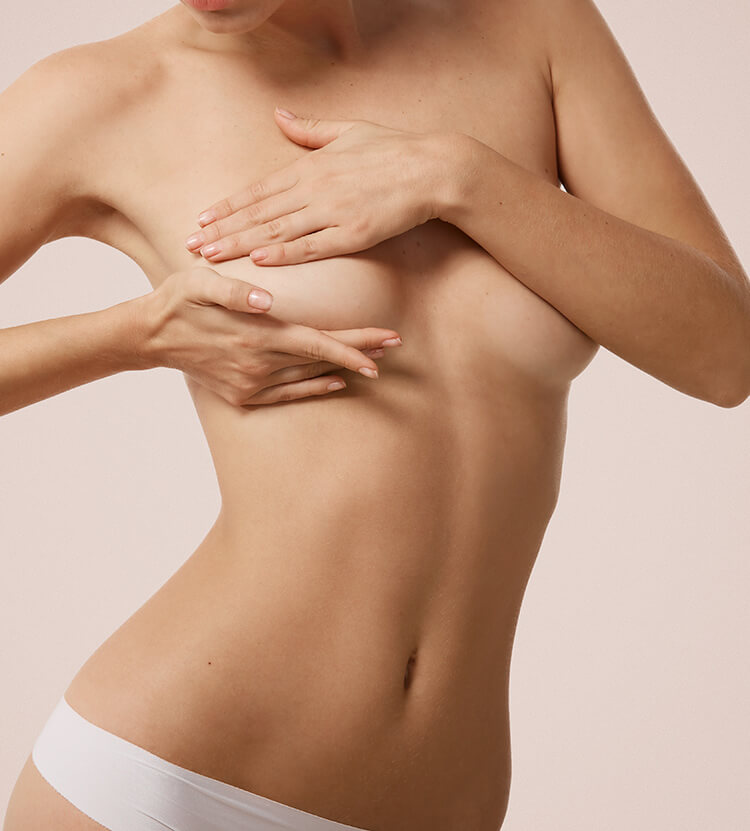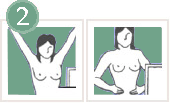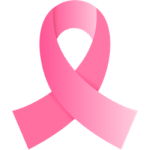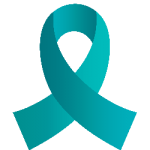Women’s Health and Beauty
Schedule A ConsultationDr. Hochstein urges women to schedule their yearly mammogram!
Breast Cancer Awarness Get Checked!
Every woman over the age of 40 should take time out of their busy schedule and schedule their annual mammogram. Your best defense against breast cancer is early detection. Dr. Hochstein recommends the following breast cancer screening guidelines to promote early detection:
- Yearly mammograms are recommended starting at age 40 and continuing for as long as a woman is in good health.
- Clinical breast exam (CBE) about every 3 years for women in their 20s and 30s and every year for women 40 and over.
- Women should know how their breasts normally look and feel and report any breast change promptly to their health care provider. Breast self-exam (BSE) is an option for women starting in their 20s.
How To Do A Breast Self-Exam
Breast Self-Exam (BSE)
 Model
Model
Taking a few minutes to do a breast self-exam a minimum of once a month can make a lifetime of difference. Nearly 70% of all breast cancers are found through self-exams and with early detection the 5-year survival rate is 98%. If you find a lump, schedule an appointment with your doctor, but don’t panic—8 out of 10 lumps are not cancerous. For additional peace of mind, call your doctor whenever you have concerns.
In the Shower

Fingers flat, move gently over every part of each breast. Use your right hand to examine the left breast, left hand for the right breast. Check for any lump, hard knot, or thickening. Carefully observe any changes in your breasts.
Before a Mirror

Inspect your breasts with your arms at your sides. Next, raise your arms high overhead.
Look for any changes in the contour of each breast, a swelling, a dimpling of the skin, or changes in the nipples. Then rest your palms on your hips and press firmly to flex your chest muscles. Left and right breasts will not exactly match—few women’s breasts do.
Lying Down

Place a pillow under your right shoulder and put your right arm behind your head. With the fingers of your left hand flat, press your right breast gently in small circular motions, moving vertically or in a circular pattern covering the entire breast.
Use light, medium, and firm pressure. Squeeze the nipple; check for discharge and lumps. Repeat these steps for your left breast.
 Model
Model
Digital Mammography
A mammogram is an x-ray examination of the breasts, used to detect and diagnose breast diseases. Screening mammography is used as a preventive measure for women who have no symptoms of breast disease.
This painless procedure does not squeeze or damage the implant as it uses computers and specially designed digital detectors to produce an image that can be displayed on a high-resolution computer monitor, and transmitted and stored just like computer files.
 Breast implants can also impede accurate mammogram readings because both silicone and saline implants are not transparent on x-rays and can block a clear view of the tissues behind them, especially if the implant has been placed in front of, rather than beneath, the chest muscles. Experienced technologists and radiologists know how to carefully compress the breasts to improve the view without rupturing the implant.
Breast implants can also impede accurate mammogram readings because both silicone and saline implants are not transparent on x-rays and can block a clear view of the tissues behind them, especially if the implant has been placed in front of, rather than beneath, the chest muscles. Experienced technologists and radiologists know how to carefully compress the breasts to improve the view without rupturing the implant.
From a patient´s point of view, having a digital mammogram is very much like having a conventional screen-film mammogram. Both film-based and digital mammography use compression and x-rays to create clear images of the inside of the breast. During all mammography exams, the technologist positions the patient to image the breast from different angles and compresses the breast with a paddle to obtain optimal image quality.
Unlike film-based mammography, digital mammograms produce images that appear on the technologists monitor in a matter of seconds. There is no waiting for film to develop, which can mean a shorter time spent in the breast imaging suite.
Mammography is a very safe procedure that uses low doses of radiation to produce high quality x-rays.
Benefits
- Imaging of the breast improves a physician’s ability to detect small tumors. When cancers are small, the woman has more treatment options and a cure is more likely.
- The use of screening mammography increases the detection of small abnormal tissue growths confined to the milk ducts in the breast, called ductal carcinoma in situ (DCIS). These early tumors cannot harm patients if they are removed at this stage and mammography is the only proven method to reliably detect these tumors. It is also useful for detecting all types of breast cancer, including invasive ductal and invasive lobular cancer.
- No radiation remains in a patient’s body after an x-ray examination.
- X-rays usually have no side effects in the diagnostic range.
 Photo By: Olivia Womack
Photo By: Olivia Womack
Warrior Strong: Elegance, Grace & Beauty.
 Photo By: Olivia Womack
Photo By: Olivia Womack
BIO: Michelle V. Maricic, R.N., MBA is an accomplished woman, athlete, Healthcare & Healthcare Technology Executive who has dedicated her career to making a positive difference in Healthcare every day. At age 63 she is a 3 times cancer survivor, most recently DX a 4th cancer with the determination to beat it once again.
PURPOSE: I’m sharing my images through the beautiful photography of Olivia Womack & am grateful for Dr. Hochstein’s artful reconstruction of my breasts following a double mastectomy. For me, I am sharing a deeper part of me & what I have learned “fighting the good fights”. WE are the “other people”. These things don’t happen to other people, they happen to us, in an instant. One day you’re great, the next you’re not. We have to share what we learn. Stronger together!!
We must be our own advocates. We don’t have to settle. We sit on top of the shoulders of advanced medical research and great Dr.s (like Dr. Hochstein) not good Dr.s… with who we get to choose to partner with.
I didn’t realize there are so many resources to help us heal. Wigs vendors that teach us about what a bald head will need for warmth. Nurses to help prevent or overcome nausea.
Dermatologist to grow hair, nails & eyelashes back. Custom lingerie fittings or prosthetics to help us overcome our missing parts. Beautiful photographers that see our beauty through their lens and bring it to light like Olivia Womack.
I hope by sharing, it brings:
- HOPE to women newly diagnosed with Cancer. Know you are not alone. Your beauty within, will be reborn.
- INSPIRATION to any woman facing adversity. We are strong and can overcome anything, if determined.
- PROMISE to love & see yourself as beautiful, despite the challenges faced.
To all women, YOU ARE STRONG & BEAUTIFUL. Let us unite & make this world a better place.
Photos By: Olivia Womack



Early Signs of Ovarian Cancer
Signs And Symptoms of Ovarian Cancer
Symptoms of ovarian cancer are not specific to the disease, and they often mimic those of many other more-common conditions, including digestive and bladder problems.
When ovarian cancer symptoms are present, they tend to be persistent and worsen with time.
Signs and symptoms of ovarian cancer may include:
- Abdominal pressure, fullness, swelling or bloating
- Pelvic discomfort or pain
- Persistent indigestion, gas or nausea
- Changes in bowel habits, such as constipation
- Changes in bladder habits, including a frequent need to urinate
- Loss of appetite or quickly feeling full
- Increased abdominal girth or clothes fitting tighter around your waist
- A persistent lack of energy
- Low back pain
When to see a doctor
 Make an appointment with your doctor if you have any signs or symptoms that worry you.
Make an appointment with your doctor if you have any signs or symptoms that worry you.
If you have a family history of ovarian cancer or breast cancer, talk to your doctor about your risk of ovarian cancer. In some cases, your doctor may refer you to a genetic counselor to discuss testing for certain gene mutations that increase your risk of breast and ovarian cancers.
Why do I need a Pap test?
A Pap test can save your life. It can find the earliest signs of cervical cancer. If caught early, the chance of curing cervical cancer is very high. Pap tests also can find infections and abnormal cervical cells that can turn into cancer cells. Treatment can prevent most cases of cervical cancer from developing.
Getting regular Pap tests is the best thing you can do to prevent cervical cancer. In fact, regular Pap tests have led to a major decline in the number of cervical cancer cases and deaths.
Do all women need Pap tests?
It is important for all women to have Pap tests, along with pelvic exams, as part of their routine health care. You need a Pap test if you are 21 years or older.
Women who have gone through Menopause (when a woman’s periods stop) still need regular Pap tests. Women ages 65 and older can talk to their doctor about stopping after at least 3 normal Pap tests and no abnormal results in the last 10 years.
How often do I need to get a Pap Test?
It depends on your age and health history. Talk with your doctor about what is best for you. Most women can follow these guidelines:
- Starting at age 21, have a Pap test every 1-2 years.
- If you are 30 years old and older and have had 3 normal Pap tests for 3 years in a row, talk to your doctor about spacing out Pap tests to every 3 years.
- If you are over 65 years old, ask your doctor if you can stop having Pap tests.
Posted Thursday, October 13, 2011 by Shellie Terry Benson, Editor

Blueberries: Cancer Fighter, Beauty Enhancer

The little blue fruit has had quite a year as researchers continue to find ways it boosts health internally and externally. The high antioxidant content (higher than nearly all other fruits) and anti-inflammation properties found in blueberries act as anti-aging agents, fighting off environmental hazards to the skin, protecting the skin from sun damage and even preventing wrinkles. Some studies suggest that eating blueberries regularly can even help improve acne-prone skin. We’ve even highlighted some beauty products that take advantage of this benefit, like Yes to Blueberries Eye Firming Treatment.
Internally, blueberries have been found to boost weight-loss efforts, cardiovascular health, maintain vision, aid in digestion and improve brain function, particularly memory. This week, researchers revealed the effects of blueberries on breast cancer. They found that mice fed blueberry powder saw a significant reduction in the growth and spread of triple negative breast cancer cells, an aggressive form of the disease that affects 10 percent to 15 percent of breast cancer patients.
Mice that were fed 5 percent freeze-dried blueberry powder had breast cancer tumors that were 75 percent smaller that those found in the control group that wasn’t fed the blueberry powder.
To get similar protection, a human would need to eat two cups of blueberries a day. Fresh is definitely best, but berries that are flash frozen retain their antioxidant levels. Any other form of berry that has been processed (canned, juiced, preserves) will lose their nutrient benefits.
So what are you waiting for? Sprinkle some on your cereal, blend some in a smoothie or top your morning yogurt with a handful!
Simple health tip for after surgery: Antibiotics and Acidophilus
Antibiotics are wonderful things, killing off all kinds of nasty stuff so it is very important to take your antibiotics after any surgery.
However, there are always problems with anything. One inherent problem with antibiotics is that they will tend to kill off things in you that you don’t want killed off.
This includes good bacteria that you are supposed to have in the intestines. Killing off these healthy bacteria thus often causes diarrhea and yeast infections for patients taking antibiotics.
Yet it is actually easy to avoid, if you know how to do it. Just compensate for what you’re losing. There are at least a couple of simple ways to do this. One is simply eating yogurt. This is the commonly recommended dietary source for these good bacterial cultures, plus it’s delicious and nutritious!
Even better, you can buy acidophilus pills as nutritional supplements at your local GNC or Whole Foods Store. If you’re just on antibiotics for a couple of days with the flu, you might just want to grab a little yogurt. If you’re on any more serious regimen, supplements can give you a much higher dosage.
After antibiotics, you need to rebalance your inner ecology in order to improve digestion and enjoy good health. Here is some quick, easy advice to help clear up the aftermath of antibiotics.
Anti-Yeast Diet
During and after using antibiotics or during any sign of a yeast infection make sure to avoid fruits, sugars, sweets, breads or other yeasty foods like beer and wine or any alcohol. Vegetables and protein are always a good idea to help stir off a yeast infection.
Pure organic coconut oil, one tablespoon after meals, may improve digestion, bloating, and immunity. It contains lauric acid, which boosts immunity, and is chemically similar to mothers’ milk. It is nourishing and tastes like coconut! Some say it is slightly slimming, but that may be because it aids digestion and absorption. Used over time it may improve leaky gut.
Rinse your mouth with water and Australian Tea Tree Oil after brushing your teeth. It makes a nice antifungal gargle. Add a drop to water or tea to help kill germs and prevent yeast problems.
Homeopathic Treatments
Do not mix homeopathic remedies with drugs. Wait until you have finished drug treatments completely then use homeopathic remedies only between meals not with food. They can help you to detoxify from medicines and prevent side-effects.
For more information or to Schedule your Appointment please contact:
1380 NE Miami Gardens Dr. Suite 105
North Miami Beach, FL 33179
305-944-3132
The Center For Gynecologic Oncology
3990 Sheridan St. Suite # 214
Hollywood, Fl, 33021
954-602-9723
Gynecology
12550 Biscayne Blvd., Suite 604
North Miami, Fl 33180
305-981-0231
The University of Texas MD Anderson Cancer Center
1515 Holcombe Blvd.
Houston, TX 77030
1-800-392-1611 (USA) / 1-713-792-6161